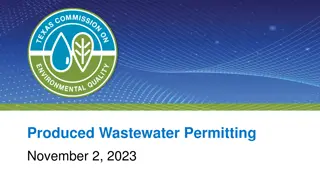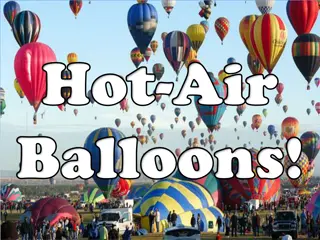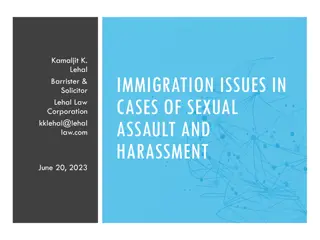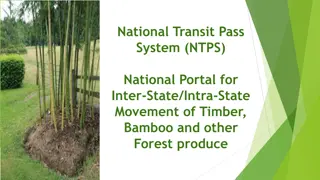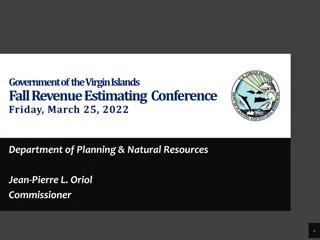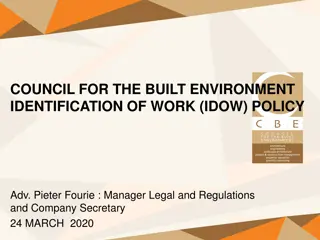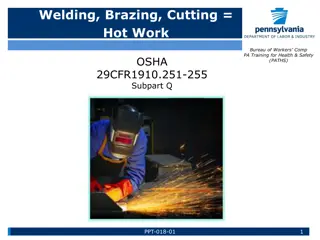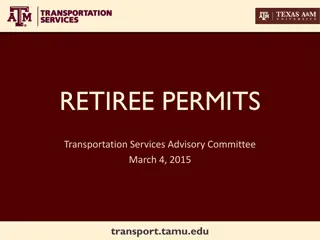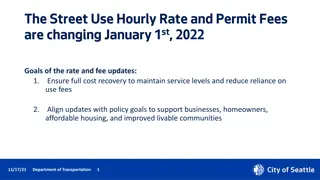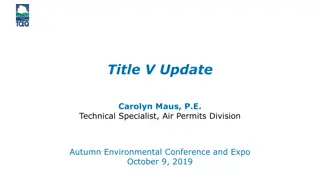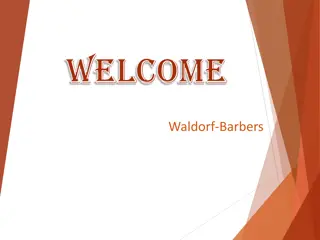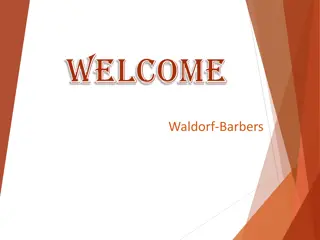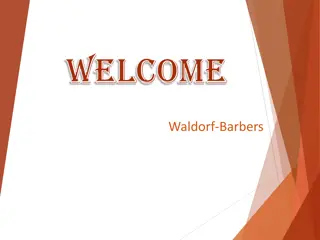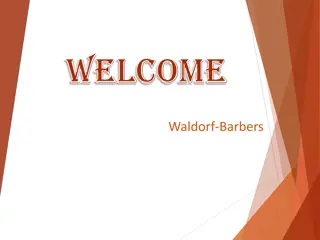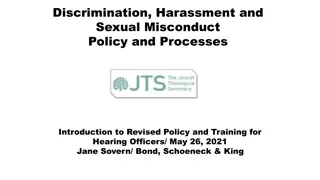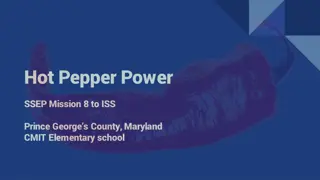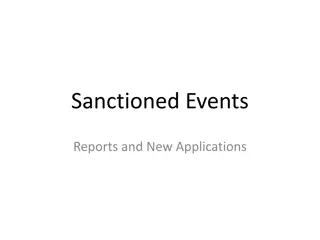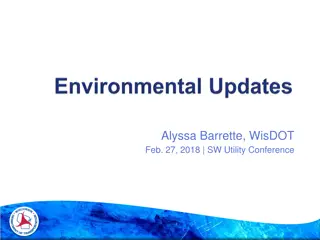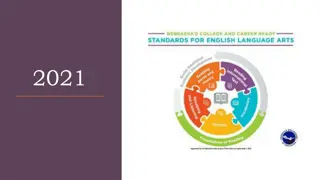Hot Work Procedures and Permits - Intrepid Policy Revised 04/2014
The Intrepid Policy outlines procedures and precautions for hot work, which includes operations involving open flames or heat production. The policy emphasizes safety measures such as flame removal, use of welding blankets, and obtaining permits. Alternative cold work methods are also suggested to eliminate risks associated with hot work. Prohibitions highlight conditions where hot work is unsafe without a specific plan. Permits are necessary for conducting hot work within a designated time frame to ensure safety and compliance.
Download Presentation

Please find below an Image/Link to download the presentation.
The content on the website is provided AS IS for your information and personal use only. It may not be sold, licensed, or shared on other websites without obtaining consent from the author. Download presentation by click this link. If you encounter any issues during the download, it is possible that the publisher has removed the file from their server.
E N D
Presentation Transcript
HOT WORK Revised 04/2014 PROCEDURES & PERMIT Intrepid Policy Key-Actions Will work generate a flame or spark Remove flammable and combustibles if possible Ensure that charged flammable gas lines and vessels not within 35 Use FM approved welding blankets or metal shields Cover/protect all floor & wall openings Plan includes fire watch and monitoring At least one 20# Fire Extinguisher & PPE Obtain permit from proper authority Check for fire continuously and for 60-minutes after (30 alt.) Monitor area for 3-hours (exceptions for affirmative measures)
HOT WORK Revised 04/2014 PROCEDURES & PERMIT Intrepid Policy Hot Work Hot work is any temporary or permanent operation that involves open flames or produces heat and/or sparks. This includes, but is not limited to, brazing, cutting, grinding, soldering, torch-applied roofing, and welding. The definition of hot work can be applied to activities within a facility, such as normal production processes, periodic/planned maintenance activities, new construction work, and emergency repairs. Hot Work Permit Special permit issued by an authorized authority
HOT WORK Revised 04/2014 PROCEDURES & PERMIT Intrepid Policy Alternative Methods Alternative cold work methods include: Mechanically removing and relocating frozen piping to a heated area rather than thawing piping in place with any form of hot work Using manual hydraulic shears rather than a cut-off saw or torch Using mechanical bolting rather than welding Using screwed or flanged pipe rather than sweat soldering Using a reciprocating saw rather than a cut-off or radial saw Using a mechanical pipe cutter rather than a torch or radial saw
HOT WORK Revised 04/2014 PROCEDURES & PERMIT Intrepid Policy Prohibitions Hot work is prohibited where it cannot be conducted safely. However, hot work may proceed under the provisions of a specific written plan (authorized at the Superintendent level) designed to eliminate or mitigate the prohibitive conditions. Examples Equipment lined with rubber or other combustible materials Oxygen-enriched atmospheres Atmosphere containing flammable gasses or mists. Hot work on tanks or vessels containing flammable or combustible liquids Equipment lined with rubber or other combustible materials shall be effectively identified by appropriate signage, markings, notices or tags.
HOT WORK Revised 04/2014 PROCEDURES & PERMIT Intrepid Policy Permits Permits are issued for a specific job being done, and for a specific time period. The time period may extend for the full working shift and under rare circumstances, multiple shifts. Normally if job is not completed by shift-change a new permit will be issued and the old permit will be replaced and retained. A master log of current hot work activity and post-hot work fire watch and monitoring will be maintained at each facility. Each hot work permit tag displays a unique identification number that can be referenced on the master log.
HOT WORK Revised 04/2014 PROCEDURES & PERMIT Intrepid Policy Authorization General Manager (or designee) Fuel tanks, oil tanks, containments Corrosive liquid storage tanks Within 100 of explosives magazine Requires special planning (otherwise prohibited) Operations Manager Underground fans, active ventilation devices In or above any air shaft Hoisting equipment, cranes and associated structures Hot work on live lines, tanks, gas lines Un-engineered/unscheduled hot work affecting the integrity of any structural component All Certified welding jobs Superintendent Hot work on Critical Flow Systems Outside normal working areas (cattle guards, fence gates, off site vehicle repair) Hot work on or in buildings constructed with combustible materials. Supervisor All others
HOT WORK Revised 04/2014 PROCEDURES & PERMIT Intrepid Policy Authorization Based on the discretion of the authorizer, voice authorization of a hot work permit may be issued for hot work to be performed at remote locations. The permit must show the name of the authorizer and all required hot work safeguards must be implemented and documented on the permit.The authorizer must sign the permit before filing.
HOT WORK Revised 04/2014 PROCEDURES & PERMIT Intrepid Policy Designated Safe Hot Work Areas A Designated Safe Hot Work area is an area that has been designed and constructed to perform open flame or spark producing work with adequate ventilation. The Safety Manager and Operations Manager will determine if a given area qualifies as a designated safe hot work area. Permanent designated safe hot work areas will be identified by signage or other demarcation. Temporary designated safe hot work areas will be posted. These areas must continuously be free of combustible and flammable materials within 35 of the work. All underground hot work not performed in designated shops must be permitted.
HOT WORK Revised 04/2014 PROCEDURES & PERMIT Intrepid Policy Enclosed Tanks and Vessels Any time hot work is performed on any enclosed tank, or vessel that contains or previously contained flammable or combustible liquids precautions shall be taken to prevent the ignition of the liquids and/or vapors that may be generated within the containment during the hot work procedure. Such precautions may include, but are not limited to purging the containment with water or inert gas and must be documented on a Hot Work Permit.
HOT WORK Revised 04/2014 PROCEDURES & PERMIT Intrepid Policy Hot Work Distance Restrictions Flammable liquids and combustible material removed from area (35 ). Work area clean from combustible or flammable dust, lint and debris (35 ). FM approved welding blankets and metal shields provided as needed (35 ). All floor and wall openings (regardless of size) covered and/or protected, walls/ceilings: remove combustibles away from opposite side adjacent structures (35 ). Underground, flammable gas tests shall be conducted in the affected area before initiating hot work, and at periodic intervals during the work. Surface or underground, such flammable gas tests shall be conducted whenever hot work is to be performed within 50 of active gas lines. Hot work shall not be performed within 50 of any explosives, blasting agent, active magazine or where explosives or blasting agents are being transported. Outdoor hot work shall not be performed in any area affected by wind currents in excess of 25 mph unless flammable and combustible materials are removed or protected in all directions for at least 50 and/or other affirmative protective actions are taken.
HOT WORK Revised 04/2014 PROCEDURES & PERMIT Intrepid Policy Protection of Areas Nearby Affirmative measures to prevent ignition (Paragraph L) Areas below the hot work site flammable and/or combustible materials below Floor openings Open grating Pipe and conduit openings Equipment openings Wall openings flammable and/or combustible materials within the walls or adjacent areas Grating Pipe and conduit openings Equipment openings Vents
HOT WORK Revised 04/2014 PROCEDURES & PERMIT Intrepid Policy Fire Watch and Monitoring Fire Watch During Hot Work During any break in activity At least 60-minutes after completing the hot work May be passed on to another qualified person May be reduced to 30-minutes if affirmative measures are employed Monitoring Period Immediately following the post-hot work fire watch. Monitor for at least 3-hours May be passed on to another qualified person May be waved or modified if approved on the permit Does not require direct or constant attendance monitoring equipment may be used Fire Watch & Monitoring Assigned person equipped with at least one 20# multipurpose fire extinguisher or approved alternative Assigned person trained on use of firefighting equipment, sounding alarm, and familiar with hot work procedures and safeguards.
HOT WORK Revised 04/2014 PROCEDURES & PERMIT Intrepid Policy Examples of Affirmative Measures to Prevent Fire Removal of all flammable and combustible materials within 35-feet in all directions Assignment of additional fire watch coverage during and after the hot work period. Maintain Effective barriers Keep combustible materials wet to prevent ignition Site Specific Factors that may Contribute to Modification of the Fire Watch Duration or Monitoring Period Duration Non-combustible construction materials Non-combustible equipment and structures (pipes, tanks, etc.) Wet floors Type of work performed (soldering vs. welding for example)
HOT WORK Revised 04/2014 PROCEDURES & PERMIT Intrepid Policy PPE Eye and Face Protection welding, flame cutting, flame soldering Include helpers Flame resistant gloves, aprons, other flame protective clothing welding, flame cutting, flame soldering ANSI rated hard had where required FM Approved welding curtains vertical containment barriers FM Approved welding curtains or other effective barriers to protect personnel from radiation Safety Shoes Other PPE required for the setting
HOT WORK Revised 04/2014 PROCEDURES & PERMIT Intrepid Policy Permit Copies and Retention Prepare permit in advance of the job. Display a copy at the work area or carry with the worker until the job, fire watch, and monitoring period are complete Permit with signatures will be filed with the Safety Office and maintained for at least 1-year after completion of all tasks associated with the permit. Training Training and refresher training as necessary for all employees affected by this policy including: Those who perform hot work Fire watch and monitoring personnel Personnel responsible for authorizing hot work Audit Safety Manager will audit compliance with this policy and report to the General Manager.


